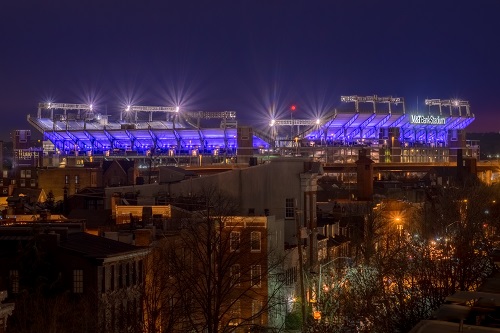

No, it’s not your imagination – you really are seeing more announcements from sports commissions nationwide about their cities’ campaigns to host the 2026 FIFA World Cup. That’s because the in-person inspections of venues and cities are finally underway.
Pick your pun: The process has finally kicked off, Cities have big goals, FIFA has gotten the ball rolling… what it amounts to is that after various delays, we’re finally seeing movement at the top. And it’s a welcome sign.
Inside World Football points out that World Cup 2026 will have 80 matches. The agreement for the hosting is for 60 of those games to be played in the U.S. with 10 each in Mexico and Canada.
According to Inside The Games, FIFA officials conducted its first U.S. visit, to Boston, on September 15, where Gillette Stadium is a potential host venue. Visitors included Confederation of North, Central America and Caribbean Association Football (CONCACAF) President Victor Montagliani, who is a FIFA vice-president, and Colin Smith, FIFA's chief tournaments and events officer. They were met by New England Patriots and New England Revolution owner Robert Kraft and Boston Soccer 2026 President Brian Bilello.
A total of 17 U.S. cities has been waiting for word from FIFA. Inside World Football notes that FIFA has developed a two-part schedule for its city and venue visits. The first round included nine U.S. candidate city visits in nine days. Those cities will be Boston, Nashville, Atlanta, Orlando, Washington DC, Baltimore, New York/New Jersey, Philadelphia and Miami.
On Sunday, FIFA officials in Baltimore were treated to an NFL game between the Baltimore Ravens and the Kansas City Chiefs. Reporters at the Baltimore Business Journal noted the game came at an opportune time. After being recognized during the third quarter and welcomed with a round of applause from the sellout crowd, the delegation got to see 70,417 fans lose their minds when the Ravens sealed a comeback win with just over a minute left in the game.
"They got to see the fanbase at its best," said Terry Hasseltine, who is helping to coordinate the World Cup site selection effort as president of the Sport and Entertainment Corp. of Maryland.
The excitement of the evening was not lost on the FIFA officials.
"What better way to start the tour than with the match last night, especially with the result going the way it did?" said Smith on Monday morning. Montagliani joked that he and Smith should take credit for the win. More seriously, he said he enjoyed seeing fans back in the stadium and enjoying themselves.
After that, it was on to the next city for FIFA as officials continued their whirlwind tour.
The remaining eight US bidding cities (Cincinnati, Dallas, Denver, Houston, Kansas City, Los Angeles, San Francisco and Seattle), the three in Mexico (Guadalajara, Mexico City and Monterrey) and two in Canada (Edmonton and Toronto) will be visited by the end of November, said FIFA.
Of the 17 U.S. cities, it is expected that 11 will get the nod for the 2026 World Cup - the first due to feature 48 teams. And those numbers make for more than a little tension. In July, Canadian host candidate city Montreal withdrew itself from the bid. But that’s far from the only drama that has plagued the process.
The Guardian notes, “There were a couple of early upsets: no Chicago – among the biggest and most alluring cities in North America, not to mention the home of the US Soccer Federation – or Vancouver, the host of the 2015 Women’s World Cup final [mentioned at one point as a possible substitute for Montreal]. However, some city leaders have been unwilling to meet FIFA’s onerous financial and legal conditions.”
Note: That comment just skims the surface; for complete detail on expectations of candidate cities and venues, as well as notes on why some cities decided to back away from the bidding table, this article has a terrific in-depth view. (The headline alone, referring to the World Cup as a “poisoned chalice,” provides a hint).
But optimism among the current candidate cities is strong, now that forward motion can be seen; in fact, if anything, cities believe they are on more equal footing than they were before.
“We’re all in the same boat here,” Chris Canetti, president of the Houston 2026 bid committee told The Guardian back in June. “The pandemic has created a challenge where everything’s had to be done virtually and FIFA has not been able to make site visits into the markets to visit the stadiums or drive through the cities. I think we’ve all been placed at an equal disadvantage.”
In Nashville, with FIFA’s visit just over, officials noted the same tone of optimism. FIFA representatives visited the Nissan Stadium, and were also planning to look at training facilities, including fields at Lipscomb University, Lipscomb Academy, Vanderbilt University, Trevecca Nazarene University, Nashville SC Stadium, and Currey Ingram Academy.
“We are assuming we are in last place and we told FIFA we will outwork everyone to show you we are the right choice,” Butch Spyridon, president and CEO of the Nashville Convention & Visitors Corporation, noted back in February. “We have improved our standing and we have a legitimate shot.”
As FIFA officials gear up for the next round of meetings, expect plenty more chatter – not to mention plenty of speculation.
Inside World Football notes that FIFA’s inspection team is led by Montagliani and Smith, but also includes “FIFA experts across multiple fields, including venue management, stadium and city infrastructure, team facilities, commercial, bidding and legal.”
FIFA said that it aims to finalize the “highly competitive selection process by Q1/Q2 2022.”

